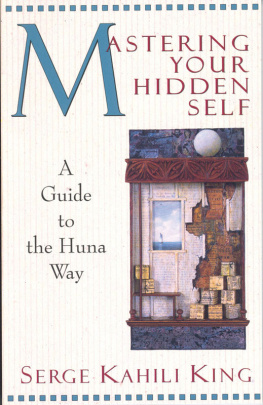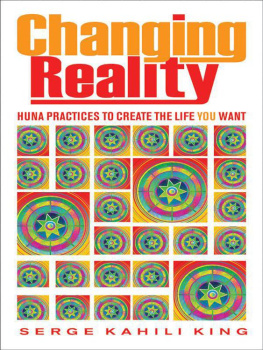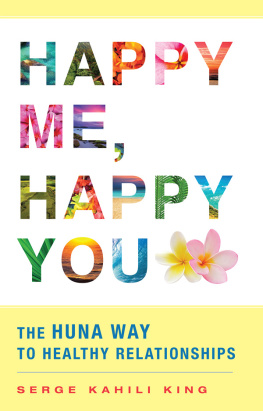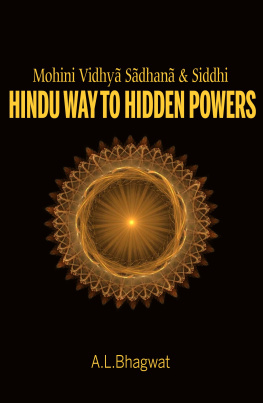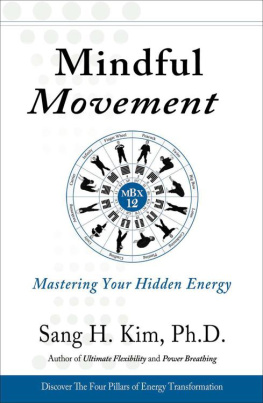About the Author
SERGE KAHILI KING, Ph.D., has been actively engaged in the fields of parapsychology, paraphysics, bioenergetics, and social technology for more than twenty years. His studies have taken him to many parts of the world, including most of North and South America, Europe, and Africa. During seven years in West Africa he conducted an in-depth study of the magicoreligious systems, while at the same time carrying out broad programs of socioeconomic development. For his latter work he received a medal from the President of Senegal.
Besides Quest books Imagineering, Kahuna Healing, and Earth Energies, Dr. King has authored Mana Physics, The Hidden Knowledge of Huna Science, and The Pyramid Energy Handbook, and many articles, courses, and lectures in all his fields of endeavor. A member of Phi Beta Kappa, he holds a Masters and Ph.D. degree and has knowledge of eight languages.
Initiated by his father into an esoteric order of kahunas at the age of fourteen, Dr. King has studied under some of the finest masters of psychospiritual knowledge from Africa to Hawaii. He directs the activities of the Order of Huna International. An ex-Marine, he lives in Princeville, HI, with his wife and three children and is engaged in research, teaching, counseling, and healing.
Mastering Your
Hidden Self
A Guide to the HUNA WAY
Serge King
A publication supported by
T HE K ERN F OUNDATION

Learn more about Serge King and his work at www.huna.org and www.sergeking.com
Find more books like this at www.questbooks.net
Copyright 1985 by Serge King
First Quest Edition 1985
Quest Books
Theosophical Publishing House
P. O. Box 270
Wheaton, IL 60187-0270
Without limiting the rights under copyright reserved above, no part of this publication may be reproduced, stored in or introduced into a retrieval system, or transmitted, in any form, or by any means (electronic, mechanical, photocopying, recording, or otherwise), without the prior written permission of the publisher of this book.
The scanning, uploading, and distribution of this book via the Internet or via any other means without the permission of the publisher is illegal and punishable by law. Please purchase only authorized electronic editions, and do not participate in or encourage electronic piracy of copyrighted materials.
While the author has made every effort to provide accurate telephone numbers and Internet addresses at the time of publication, neither the publisher nor the author assumes any responsibility for errors or for changes that occur after publication. Further, the publisher does not have any control over and does not assume any responsibility for author or third-party websites or their content.
Cover design by Beth Hansen-Winter
Cover art by Jonathan Talbot
Library of Congress Cataloging-in-Publication Data
King, Serge.
Mastering your hidden self.
(A Quest Book)
A Quest original.
1. Occult sciences. I. Title.
BF1999.K49 1985 133 84-40509
ISBN 978-0-8356-0591-5
ISBN for electronic edition, e-pub format: 978-0-8356-2030-7
14 13 12 * 11 12 13 14 15
This book is dedicated to Gloria Dawn Denkhaus, my best student, my best friend, and my wife.
Acknowledgments
Acknowledgments are due to all my students whose feedback enabled me to keep refining this material; to Jane Roberts and Barry Kaufman, from whose books I borrowed certain phrases to explain the Huna knowledge; to my editor, Shirley Nicholson, whose good advice helped to stabilize the theme of the book; and finally to my typewriter, Fred, whose persistent good will kept the manuscript flowing.
Contents
Preface
Since my last book, Kahuna Healing, many people have asked me about practical applications of Huna insight into the nature of the self, which is the reason for bringing out the present book. They have also asked me about my own training as a kahuna. Since this has a great deal of hearing on your use of this book, I'd like to talk story a hit on that subject.
In my life so far I've experienced many different forms of training, including school and college, postgraduate studies, the military, special language and technical courses, and others. In my opinion, kahuna training was the hardest of all. Perhaps I can explain that better by relating a few incidents of such training.
My father was my toughest teacher. Before I understood what kahuna training was all about, I harbored a lot of resentment toward him for certain things he did. One occasion that stands out in my memory took place when I was fifteen. We were building a house, working in the basement, and he told me to get him an awl. I had never heard of an awl, so I asked him what it was. He simply said, Just go get one. Well, instead of applying anything I had learned the previous year about intuition and awareness, I got mad at how unfair he was. I blocked my mind to everything but my anger, and of course found nothing even resembling an awl. After a few more wasted trips and mounting resentment on my part, he went and got the thing himself.
You could say he should have described an awl to me so I could have found it and learned what it was. But the lesson had nothing to do with awls. Nor did it have to do specifically with using my extended awareness to intuit what an awl was or to pick it out of a tool box. If that were the case, my father would have said, as he had on many other occasions, Use your mind. No, the lesson in this case was about initiative. I knew how to be more observant in the present moment, which would have included being aware of what my father was working on and what would be logically necessary or useful to enable him to continue (e.g., something to make a hole with), and I knew how to let my mind bring images according to my intent and how to let my subconscious lead me toward things I might be looking for. What my father did was to give me an opportunity to use what I knew. What I did, in that instance, was to put my energy and talent into feeling sorry for myself.
In Africa once, a few days after my mentor, M'Bala, had guided me through a particularly powerful experience of becoming a leopard, he handed me a kind of large, stone bead, without saying anything. What's this? I asked. A stone, he replied. I can see that, I said, but what's it for? Is it an amulet? It could be used for one, he said, indifferently. Feeling a little frustrated, I asked, Well, what am I supposed to do with it? Anything you like, was his answer. So I just thanked him for it with a shrug and put it in my pocket. In all the rest of the time I spent with him, M'Bala never referred to the stone again. It wasn't until five years later, back in the States, that it occurred to me to apply the knowledge of the leopard experience for tuning in to the stone. Doing something with it was entirely up to me.
Fortunately, I wasn't that dense during all my lessons. By the time I started working with my Hawaiian uncle, Wana Kahili, I was doing a lot better. He would suggest a practice, and I would do it and extend it as far as I could and tell him my results; he would suggest refinements or further extensions, and I would follow those and add inventions of my own; he would either guide me further in that direction or suggest a new one. As long as I kept moving, he would keep teaching and I would keep learning. If I failed to follow up on anything, it was simply dropped and never mentioned again, until and if I did something with it. For the kahunas, self-development means that responsibility for your development lies with yourself. There is no limit as to how far you can go, and there will always be a guide of some kind available at every stage. But each person has to get there on his or her own two feet. There is no one to push you or pull you, coax or cajole you, force you or lead you along. And that's why it's tough.

